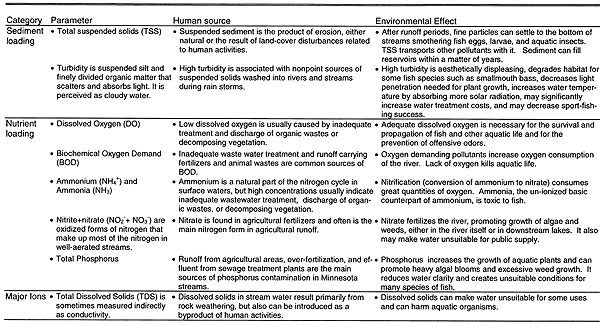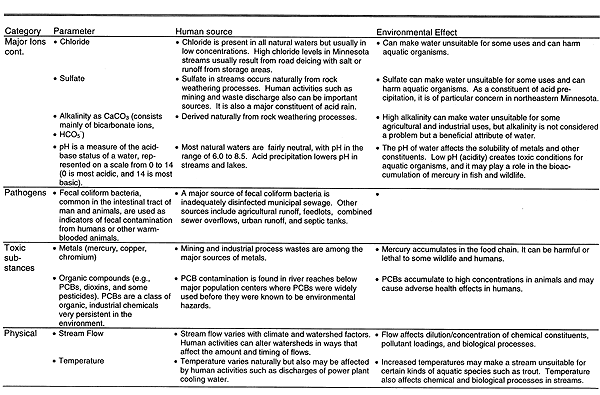 |
 |
WATER QUALITY MONITORING
Information on Minnesota’s river water quality comes from monitoring activities undertaken by federal, state and local agencies and by non-governmental organizations. This section first describes the general uses of water quality data and how it is collected and analyzed. The remainder of this section focuses on specific federal, state and local water quality efforts.
Water quality sampling is undertaken to establish baseline conditions and monitor trends, to monitor compliance with environmental regulations, and to study specific issues or locales. Monitoring data that describe ambient conditions are used to establish baselines and trends. Consistent, long-term ambient monitoring assists in the detection problems or threats to resources before they become obvious or irreversible. Ambient monitoring also provides the information needed to evaluate the effectiveness of management programs and projects. Compliance monitoring data are used to evaluate the effectiveness of point source contaminant controls. Discharge permits generally require permit holders to collect and report data on the quality of water discharged to ensure it meets state and federal quality guidelines.
Special monitoring programs also are established to develop basic water quality information in relation to a particular issue of concern. These programs generally run for a limited period and data from such efforts may not be useful for drawing conclusions about temporal trends. However, they can be more useful when integrated with compliance and ambient data.
Monitoring the state’s surface water quality entails collection and analysis of water samples from locations throughout Minnesota. In theory, monitoring stations are chosen to reflect water conditions in all regions of the state. Minnesota’s ambient water quality monitoring program began in 1953. Although the number and location of sampling sites have varied, extensive data are available for 42 sites. Over the past 40 years, the PCA monitored each of these sites for 20 or more years. The PCA also oversees monitoring of discharge sites for municipal and industrial facilities, such as wastewater treatment plants, to ensure compliance with permit conditions. The local operator of the treatment plant does most compliance monitoring, and it involves testing the effluent to determine that it meets discharge limits, rather than testing in the stream for impacts. The state also tests rivers for the presence of pesticides and nutrients to track compliance with regulations. The types of analyses conducted depend on specifics of the applicable law or permit. The state does a limited amount of fish tissue monitoring in rivers, usually in the most heavily-fished ones. When fish tissue analyses indicates a potential problem, sediments are sampled and analyzed to identify the source of contamination.
Monitoring agencies use several approaches to measure water quality: chemical analyses of water and sediment samples, biological surveys and toxicity testing, and analyses of fish and wildlife tissue to measure accumulation of toxic pollutants. Routinely measured parameters that affect designated uses of streams and rivers fall into six categories: sediment (total suspended solids and turbidity), nutrients (dissolved oxygen, biochemical oxygen demand, nitrate and phosphorus), major ions (total dissolved solids, chloride and sulfates), pathogens (fecal coliform bacteria), toxic substances (metals and organic compounds), and other basic water quality parameters (pH and temperature) (Table 5.2). Analyses of fish tissue to measure accumulation of toxic pollutants include PCBs, dioxin, organochlorine pesticides, and mercury. To identify potential human health threats to those consuming fish exposed to toxic pollutants, only the commonly eaten parts are analyzed. To measure the incidence of bioaccumulation of toxic pollutants, organs and fat that are known to accumulate contaminants are analyzed.
Other indicators of stream water quality include bioassays for toxicity and biological community assessments. Bioassays test the ability of organisms, like Daphnia (a relatively large-bodied zooplankton) and fathead minnows, to live in effluent, ambient water or sediment over a fixed time period. Biological community assessments provide a holistic indicator of stream water quality on a seasonal basis by evaluating the structure of the biological community in a specific area using data on the type and population of observed aquatic species.


Table 5.2 Commonly Measured River Water Quality Parameters